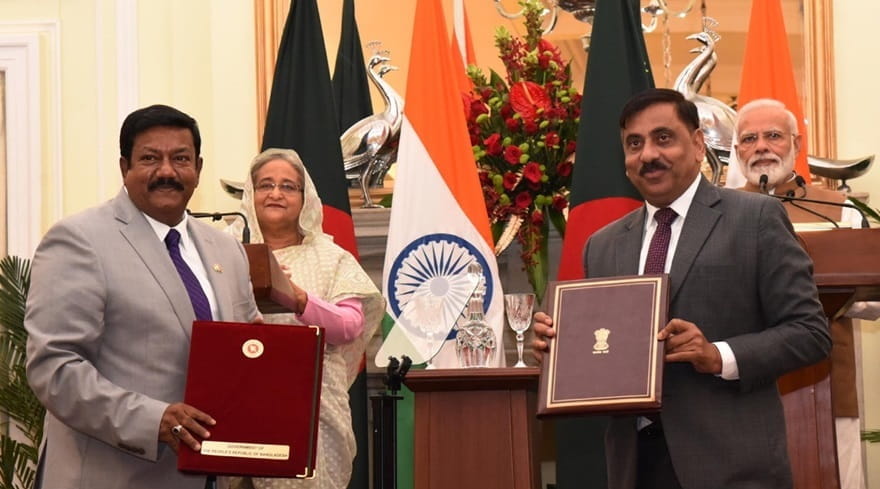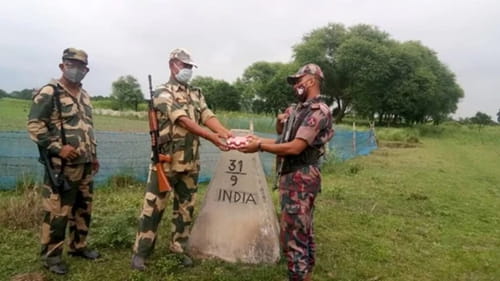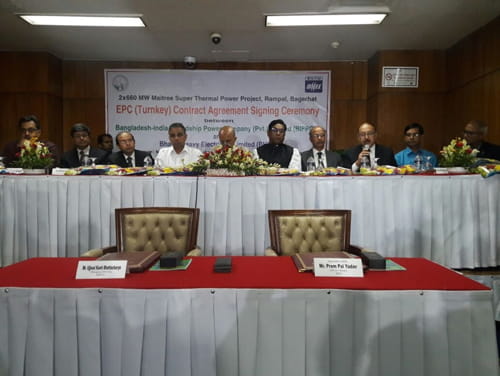
Bangladesh and India exchanging a list of MoUs/Agreements in New Delhi, 2019 | pmindia.gov.in
This article is the second in the three-part series by Dr. Imtiaz Ahmed, who discusses Bangladesh-India relations in a multipolar world. He argues that Bangladesh and India have forged a unique collaboration in security matters, which makes Bangladesh vital to India for ensuring its security. At the same time, India remains essential to Bangladesh for safeguarding its security from regional and extra-regional threats.
Introduction
Globalisation creates grounds for multipolarity, with the potential of devising what could be referred to as the geopolitics of cooperation. Since the Europeanization of the world, geopolitics always had a negative conflictual connotation. Theorists of the 19th and 20th centuries, conceptualising geopolitics in the backdrop of colonialism and lebensraum (living space), were primarily responsible for this. Johan Rudolf Kjellen (1864-1922), Karl Haushofer (1869-1946), Alfred Thayer Mahan (1840-1914), Friedrich Ratzel (1844-1904), Halford John Mackinder (1861-1947) all advocated geopolitics of conflict, as countries would be passionately engaged in conflicts for bringing territories of near and faraway places under their control for reproducing and enhancing their powers.
However, that was the policy of yesteryears, and the theories of geopolitics that were promoted then became redundant in the aftermath of decolonization, the transformation of national capitalism into globalisation, and the emergence of multipolarity. Since post-colonial India and post-colonial Bangladesh have embraced globalisation and multipolarity and are ready to engage with the uncertain but promising world, as indicated earlier, both would be eager to promote the geopolitics of cooperation and make the best of it to serve their national interests. The following sectors will make this clear.
Security
Bangladesh and India have forged a unique collaboration in security matters, which makes Bangladesh vital to India for ensuring its security, particularly in the context of India’s northeast, as indicated earlier. At the same time, India remains essential to Bangladesh for safeguarding its security from regional and extra-regional threats.
In this context, geography remains critical both ways. If India surrounding Bangladesh makes the former attentive to the latter, lest the country become unstable and a security concern for India, so does Bangladesh, with its geographical location, can make India vulnerable by aligning with regional and extra-regional actors. This has made Bangladesh and India indispensable to each other in security matters, albeit without making them constrained in developing partnerships with regional and extra-regional actors, provided such partnerships are not related to exclusive security collaboration with a third country. The unique cooperation saw three outcomes.
Firstly, as indicated earlier, Shaikh Hasina’s zero-tolerance policy on foreign insurgencies taking shelter in Bangladesh made India understand how critical Bangladesh is regarding its security in the northeast. Bangladesh's cooperation helped India negotiate with ULFA and sign a peace accord for a militancy-free Assam in New Delhi on 23 December 2023.1

India’s Border Security Force and Bangladesh’s Border Guard Bangladesh exchange sweets at a border outpost on Eid al-Adha, 2021 | ANI
Bangladesh, too, is aware of its importance and, therefore, came out openly to criticise the derogatory comments of a senior Indian politician when the latter referred to the ‘illegal immigrants’ from Bangladesh as ‘termites’!2 However, few can deny that Bangladesh and India, as neighbouring countries, have developed a unique security partnership without compromising their respective sovereignties.
Secondly, Bangladesh could diversify the purchase of military equipment, which, apart from the cost, is geared toward assuaging suspicion in other countries, mainly its immediate neighbour, India. The list of equipment of the Bangladesh army, for instance, will show China, Turkey, Italy, Germany, Austria, Russia, Australia, Romania, Singapore, Serbia, France, Belgium, Argentina, Indonesia, the United Kingdom, the United States, even India, from where Bangladesh purchased multi-utility vehicles. Bangladesh plans to buy more military hardware from India once the USD 500-million line of credit for defence purchases gets operationalized.3
Thirdly, given the unique cooperation, it is no wonder that India decided to line up with Russia, China, and Japan, amongst many other countries, in contradistinction to the United States and some European countries, not to interfere in the internal affairs of Bangladesh, and preferring to look only with interest Bangladesh’s national election on 7 January 2024. This prompted the United States and several European countries to abandon their earlier path of pressuring the government to heed the opposition’s demands to create conditions for its election participation. Instead, they opted for a course correction immediately after the election. They welcomed the new government led by the ruling party, lest they become isolated and further alienate Bangladesh from them.
Despite the unique collaboration in security matters, insecurity still prevails in the border areas of India and Bangladesh. This relates to the border killing of Bangladeshis by the members of the Border Security Forces (BSF) of India. According to the Bangladesh Peace Observatory, India’s BSF shot and killed 1429 Bangladeshis in the last ten years from 2012 to 2022, that is, 142 people annually.4 However, one must quickly note that the number of deaths has subsided in recent years, from as high as 241 in 2014 to 98 in 2022.5 Still, any killing of an unarmed person with firearms is unlawful and subject to judicial proceedings, which the Government of India remains shy of carrying out. This robs the merit of the unique cooperation the two countries have worked so hard to build.
Only recently did the two countries agree to use “non-lethal weapons to reduce border killing”.6 An added option would be to replicate the agreement between India and China of November 1996, where Article 6:1 stipulates, “Neither side shall open fire, cause bio-degradation, use hazardous chemicals, conduct blast operations or hunt with guns or explosives within two kilometres from the line of actual control”.7 A binding agreement of this kind would go a long way in resolving the border killing issue and putting an end to the criticism of India in Bangladesh conclusively.
Connectivity
The cartographical massacre of Bengal in 1947 had a lasting impact when it came to disconnecting the people of India and Bangladesh. There was some hope that reconnection would occur following Bangladesh’s independence in 1971. However, it took nearly four decades, more so following Sheikh Hasina’s return to power in 2009, for the two countries to put their minds and resources into connectivity. While commenting on the inauguration of the cross-border energy pipeline between Bangladesh and India in March 2023, Siddhartha Singh, a senior research fellow at India Foundation, noted, “Connectivity has emerged as the key ingredient of strong India-Bangladesh relations”.8
However, such connectivity was not limited to waterways, roads, and railways, which were particularly prominent in the pre-1947 era; it now included energy and digital connectivity. Looking at the current state of cooperation between Bangladesh and India and the drive for infrastructural development of both countries, one can see the prospects of connectivity at three levels.
Firstly, India’s push for connectivity coincides with Bangladesh’s interest in a more significant relationship with northeast India. “Cross-border buses operate along five different border routes connecting India’s States of Assam, Meghalaya, Tripura, and West Bengal with Bangladesh”, and Bangladesh has also undertaken projects with India targeting the northeastern states of the latter, including the Matabari deep seaport.9The seaport is destined to facilitate the exports and imports of northeastern states, with Bangladesh benefiting from the transactions of goods and raw materials. In this context, the Akhaura-Agartala cross-border rail link would play a vital role, as would the Khulna-Mongla port rail line, the agreements of which were signed between the two countries in November 2023.10
One World Bank report suggests that transportation connectivity alone could boost India’s and Bangladesh’s national income by 8 percent and 17 percent, respectively.11 Connectivity, if it were to be sustainable, would require profitable outcomes for both countries.
Secondly, the construction of the Padma Bridge, although commissioned after the World Bank’s reluctance to fund the project and China coming forward to support Bangladesh’s ‘dream project,’ is bound to facilitate trade relationships with India as much as it would do with the United States, Japan, South Korea, and many more countries, and not be limited to promoting only Bangladesh-China trade relationships. This is the uniqueness of a developmental partnership compared to a security partnership.
As indicated earlier, Bangladesh’s foreign policy principle allows the country to forge alliances with all the world's sovereign nations so long as they are inclusive and do not include exclusive relationships with a government or group on security matters. This has also been made clear in Bangladesh’s Indo-Pacific Outlook, which was declared in April 2023.12 In this context, Bangladesh’s infrastructural development, whatever the source of funding, allows for a win-win situation for those interested in doing business with Bangladesh.
Thirdly, the more the countries engage in connectivity, as the constructivists would argue, the greater the potential for deepening mutual trust and initiating major works among them with more imagination and long-term goals. In this context, connectivity should extend beyond recovering earlier waterways, roads, and railways. One good example would be the signing of the two-phase Maitree super thermal power project, the first phase in September 2022 and the second in November 2023. As Rezaul Laskar contends, “The project is meant to meet the growing energy needs of the people and businesses in southern Bangladesh and contribute to energy security in the neighbourhood”.13

In 2016, India and Bangladesh had signed for the Maitree Super Thermal Power Project at Rampa, Bangladesh | X: @ihcdhaka
Bangladesh and India must also start planning on newer connections, including constructing Dhaka-Delhi high-speed train lines, which will undoubtedly change the region's landscape and the quality of people’s connectivity.
Trade and investment in the age of globalisation
The internationalisation of production or globalisation has qualitatively transformed trade and investments between countries. Export and import figures have become complex, with export items having import components and vice versa. A good example would be the ready-made garments (RMG) sector. Bangladesh can certainly take pride as the number 2 producer of RMG products globally, second only to China, but the components of those products remain ‘international’! This is because the bulk of the raw cotton comes from India, which takes 35 percent of Bangladesh’s import market, followed by Brazil at 13 percent and the United States at 7 percent.14 Bangladesh is the world's third-largest importer of raw cotton after Vietnam and China.15 At the same time, most machines were imported from Europe.
However, now Bangladesh imports most of its cotton machines from India, China, and Pakistan.16 Bangladesh’s component is mainly labour, although the local backward-linkage industry now feeds into the RMG sector.17 The same applies to most products now made globally, whether IBM computers, iPhones, or SUVs. This indicates that bilateral trade and investment can not only be two-way but also multilateral and international.
Trade and investment between India and Bangladesh must be considered in the above-mentioned context. The figures for bilateral trade will show steady growth from USD 7 billion in FY 2017 to around USD 18 billion in FY 2022, with Bangladesh’s exports to India reaching nearly USD 2 billion in FY 2022.18 Bangladesh, too, has emerged as India’s biggest trade partner in South Asia. This has two implications. Firstly, the trade volume between the two countries is bound to increase as more and more Indian investors are likely to invest in Bangladesh and have the goods imported back to India to ensure a greater profit margin. This also creates an opportunity for Bangladeshi investors to invest in India, particularly in the textile and garments sector, which has already earned global fame.19
Secondly, the complex trade and investment regime creates a win-win situation for both countries and an interdependency from which neither would want to withdraw, lest both suffer economically. This creates conditions for resolving other contentious issues, even tolerance of each other’s economic partnership with other countries.
However, while it holds potential, India is yet to become one of Bangladesh's top development partners. The data from the last 52 years show that India lags behind Japan, China, Russia, the United States, and a few other countries in bilateral development partnerships with Bangladesh.20
Hydropolitics
The Teesta River has remained a thorny issue between Bangladesh and India, and more so following an agreement of the draft between Bangladesh and India’s central government under Manmohan Singh in September 2011, but there is reluctance from the Indian State of Paschim Banga under Mamata Banerjee to approve the draft, which is mandatory as per the Indian Constitution. One could argue that Banerjee had good reasons to stall the agreement over the Teesta River with Bangladesh.
From her standpoint, given the scarcity of water and before deciding to share with Bangladesh, she wanted a guarantee from Delhi on how much water Sikkim, from where the Teesta originates, would be willing to release and share with Paschim Banga. This is a fair demand, particularly when reports indicate that Sikkim runs 26 live hydropower projects over Teesta.21 But then, critics believe that Mamata Banerjee also took the opportunity to pressure Delhi to create an economic package for Paschim Banga in exchange for her consent to the Teesta agreement.
Things have proved difficult on both accounts. Bringing Sikkim into the fold, in addition to Paschim Banga, to negotiate an international agreement would dilute the federal government's power, which Delhi is unwilling to part with. As for the economic package from Delhi in exchange for consenting to India’s foreign policy initiative vis-à-vis Bangladesh, indeed, a federal matter, amounts to ‘blackmailing’ the central government! Moreover, there is misgiving about Mamata Banerjee now, whether her opposition to Teesta and her earlier opposition to the exchange of enclaves were motivated by economic reasons.
That is, catering to the interests of the non-Bengali business community in Paschim Banga, the latter is less keen on a newer Bangladesh-India relationship, including ‘pan-Bengali fondness,’ as it would create space for Bangladeshi entrepreneurs and make them a competitor, particularly in northeast India where the non-Bengali business community holds a monopoly when it comes to economic activities there. However, hydropolitics in the age of multipolarity, with the backdrop of unresolved issues and complicated inter-state relationships, can open space for collaboration with other regional actors and beyond to resolve the issue. This is where Bangladesh’s proposed alternative policy to resolve the Teesta issue merits attention.
The flow of Teesta is seasonal. During the rainy season, the flow is more than adequate. In fact, due to the lack of dredging over the years, the water often overflows and causes floods on both sides of the river.22 However, out of the 115-kilometre course of the Teesta inside Bangladesh during the dry season, at least 102 km of it dries up.23 Bangladesh has waited for over 12 years now for an equitable share of the Teesta water as the finalised draft agreement stipulated 42.5 percent of the water for India and 37.5 of the water for Bangladesh. The remaining 20 percent of water would be kept for river navigability.24
As indicated earlier, no agreement could be reached because of Paschim Banga’s objection. This created space for Bangladesh to look for alternatives. Since thousands of families in northern Bangladesh are affected during the dry season, resolving the issue is urgent, lest it becomes a hotspot for agitation against the incumbent government for economic stress.25
One credible solution is to store the water inside Bangladesh during the rainy season and use the stored water during the dry season. However, this solution is not without cost. This is where China enters the Indo-Bangladesh hydro-politics following the latter’s request for a USD 983 million loan from China to implement a “Teesta River Comprehensive Management and Restoration Project”.26 In many ways, this is similar to China’s support of the Padma Bridge following the World Bank’s refusal to fund the project, as indicated earlier. China's involvement would not have arisen if India could have resolved the water issue by signing the draft agreement on Teesta in the last 12 years. This is the possibility of multiple options one talks about that emerge from multipolarity, with no one country holding the power to resist the developmental aspirations of others.
Moreover, if India feels threatened by China’s involvement, the best would be for India to join the initiative and have a tripartite Bangladesh-China-India arrangement to build the water storage. India would then be relieved of the problem of sharing the Teesta water, which, in the backdrop of dam construction in Sikkim and agricultural requirements of Paschim Banga, is a non-starter, if not impossible to implement.
(Exclusive to NatStrat)
Endnotes: